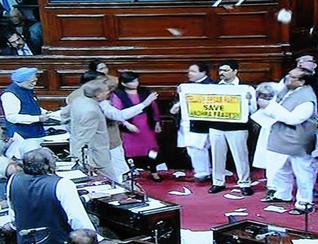New Delhi, Feb 20: Telangana was all set to become 29th state of the Union with Parliament tonight approving a historic bill to carve it out of Andhra Pradesh amid vociferous protests by members from Seemandhra region as also from Trinamool Congress and Shiv Sena.

Apparently responding to demands from Seemandhra MPs as well as from BJP for "justice" to the region, Prime Minister Manmohan Singh announced a six-point development package for successor states of Andhra Pradesh including grant of special category status including tax incentives to Seemandhra.
Congress President Sonia Gandhi's request to the Prime Minister to give a special category status to Seemandhra for five years seems to have apparently clinched the issue and BJP came on board.
"I hope these additional announcements will demonstrate our steadfast commitment to not just the creation of Telangana but also to the continued prosperity and welfare of Seemandhra," Singh noted.
A protective cordon was thrown around Singh as well as Home Minister Sushilkumar Shinde by Congress members as members from Seemandhra region as also those from TMC and Shiv Sena stormed the Well with TMC members even tearing papers and throwing them on the floor.
CPI-M members walked out in protest.
The House looked like a virtual battle-ground during the five-hour proceedings, which saw seven adjournments as members resorted to slogan shouting and tore papers describing the bill passed by the Lok Sabha on Tuesday as illegal.
The debate also saw the government facing an awkward situation when Union Minister Chiranjeevi, who hails from Seemandhra region, opposed the decision on Telangna inviting ridicule from BJP, which wondered whether a member of the Council of Minister can oppose a decision taken by his own government without resigning from it.
As the bill appeared set to be a reality with most of the amendments moved by the BJP either negatived or withdrawn, CPI-M and Trinamool Congress alleged "nexus" between the ruling party and the main Opposition.
Minister Jairam Ramesh, who was a key person in the Telangana decision process as a member of the GoM on the issue, repeatedly made brief intervention to assuage the concerns of members on diverse issues.
Law Minister Kapil Sibal said time has come to create Telangana. "Time has come to take this historic decision...it is very difficult to satisfy all people of both the regions."
Deputy Chairman P J Kurien rejected demands for division taking the plea that there was no order in the House.
Unlike Lok Sabha, where the bill was passed after a very brief discussion, Rajya Sabha saw a threadbare debate spanning around three hours despite unprecedented protest with anti-Telangana members storming the well with huge placards sometimes even overshadowing the Chair.
Similarly, unlike the television black out that was witnessed during the proceedings in Lok Sabha, there was no such "technical glitch" on the Rajya Sabha TV, which telecast the proceedings live.
Commotion and high drama continued throughout the proceedings with Congress member K V P Ramchandra Rao staging a sit in into the Well and Trinamool members shouting "tear and throw away".
There was no suspension of any member from the House of the Elders today unlike what happened in Lok Sabha, where as many as 16 Seemandhra members belonging to various parties faced action.
BJP, which supported the bill also demanded that Seemandhra region got justice and a "defective" legislation was not passed.
The principal Opposition party also deplored government for badly handling the passage of the bill without taking the stakeholders on board.
"Telangana and Andhra Pradesh are both brothers and are Telugu speaking. Telangana people want Telangana, we are saying yes...We are not dividing the country, we are only dividing a state for speedy development," Naidu said.
Naidu blamed Congress for delaying creation of Telangana and playing "vote-bank" and "opportunistic" politics on the issue and said it is the "real culprit" in this whole process.
He also sought amendments to give special category status to Seemandhra and adequate financial package to address the revenue loss of the region.
Supporting his colleague, Leader of the Opposition Arun Jaitley said, "We are in favour of creation of Telangana. But we want a lawful and legally sustainable bill be passed."
"I am deeply disappointed the way the UPA government has done the creation exercise," he said, highlighting expulsion of members in the other House, the state assembly rejecting the proposal and others.
Replying to Naidu's concerns regarding the resource gap arising between the notified date and appointed date for creation of Telangana, both Shinde and Ramesh assured him that Government will take care of that and quoted the Prime Minister's statement in this regard.
In his statement, the Prime Minister noted that the resource gap arising in the successor state of Andhra Pradesh in the very first year will be compensated in the Regular Union Budget for 2014-15.
This gap may arise during the period between the appointed day and the acceptance of the 14th Finance Commission recommendations by the Government of India.
Concerns were also raised during the debate over Polavaram project, which Ramesh sought to explain.
Sitaram Yechury (CPI-M) said, "There is match-fixing between the ruling party and the Opposition" adding that the Chair should not get into such match fixing.
Trinamool Congress members kept shouting "Congress-BJP bhai, bhai".
Trinamool Congress is concerned about the fall out of the Telangana decision on Gorakhaland issue. The hilly region of West Bengal is seeking separate statehood for long.
Similarly in Maharashtra, Shiv Sena has been staunchly opposed to any division of the state, where demands for creation of Vidarbha are raised occasionally.






Comments
Add new comment